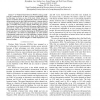Free Online Productivity Tools
i2Speak
i2Symbol
i2OCR
iTex2Img
iWeb2Print
iWeb2Shot
i2Type
iPdf2Split
iPdf2Merge
i2Bopomofo
i2Arabic
i2Style
i2Image
i2PDF
iLatex2Rtf
Sci2ools
GLOBECOM
2007
IEEE
2007
IEEE
A Group of People Acts like a Black Body in a Wireless Mesh Network
Abstract— A Wireless Mesh Network (WMN) is being considered for commercial use in spite of several unaddressed issues. In this paper we focus on one of the most critical issues: the impact of ambient motion of entities like people on the channel characteristics and on the WMN performance. A human body in an Electro-Magnetic (EM) field acts as an scatterer that absorbs 60% of incident EM energy, thereby shadowing the receiver. This human body model along with the human mobility behavior gives rise to a black body (a group movement) effect that traps the incident EM wave with repetitive internal reflections. The black body theory is verified by simulating the WiSEMesh testbed in picoKAIST, a tool based on deterministic ray tube method. Experimental results show each link exhibiting a unique channel variation pattern in presence of the black body. Based on the pattern we provide several insights in WMN deployment and protocol design.
| Added | 02 Jun 2010 |
| Updated | 02 Jun 2010 |
| Type | Conference |
| Year | 2007 |
| Where | GLOBECOM |
| Authors | Sachin Lal Shrestha, Anseok Lee, Jinsung Lee, Dong-Wook Seo, Kyunghan Lee, Junhee Lee, Song Chong, NohHoon Myung |
Comments (0)

